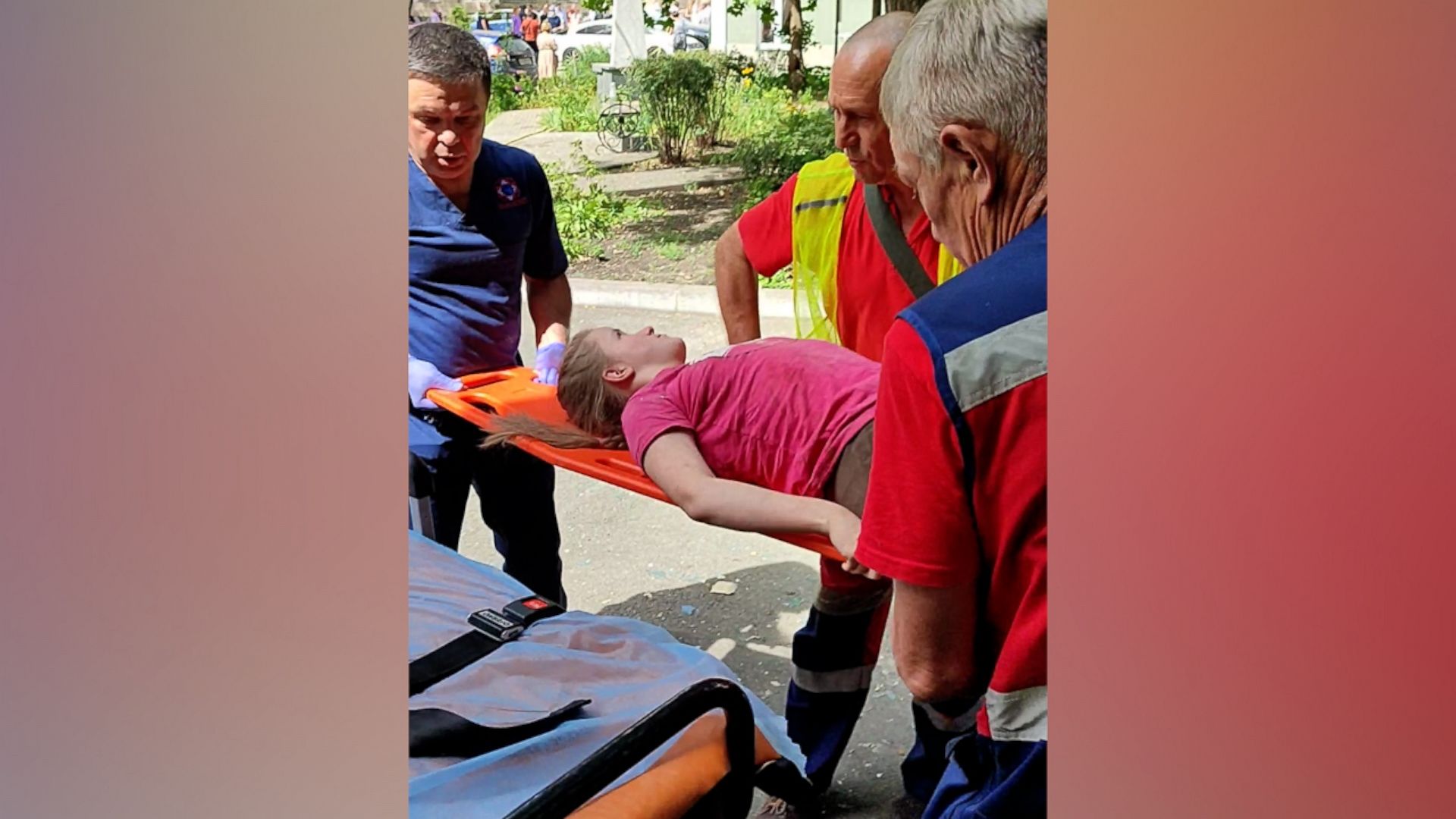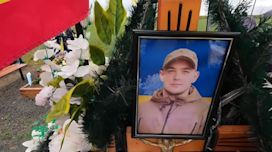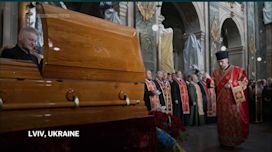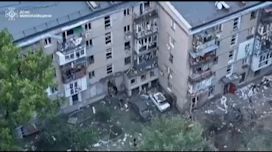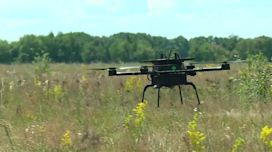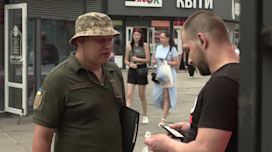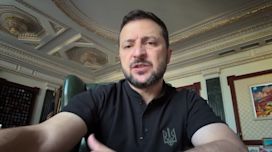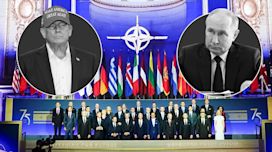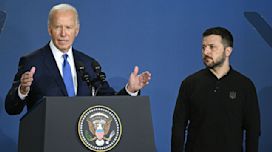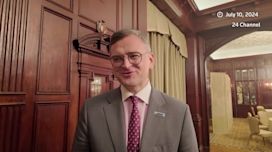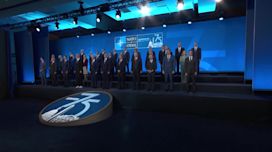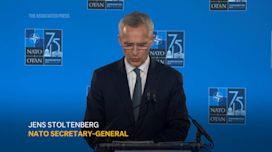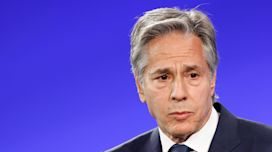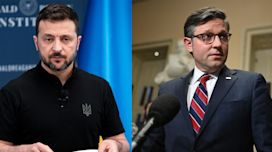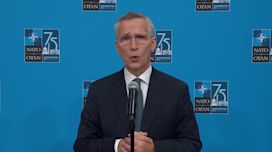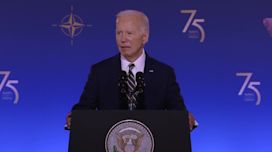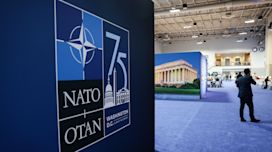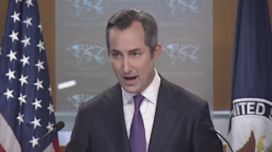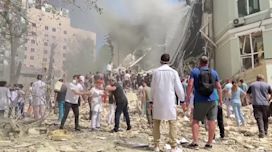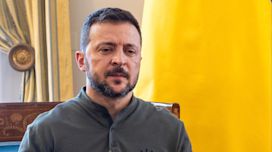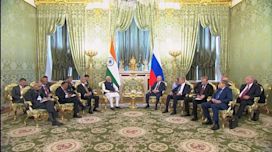Search results
1 day ago · This is where the war stands on Friday, July 26, 2024: Fighting. Russia targetted Ukrainian energy facilities in the northern regions of Chernihiv and Zhytomyr overnight with drones, causing ...
Girl recounts attack on Ukraine children's hospital
ABC News Videos2 days agoSolomiya Fomeniuk, 16, recalls the missile strike on the Okhmatdyt pediatric hospital as both horror and a miraculous survival.
Up Next
- 0:55Girl recounts attack on Ukraine children's hospitalABC News VideosSolomiya Fomeniuk, 16, recalls the missile strike on the Okhmatdyt pediatric hospital as both horror and a miraculous survival.2 days ago
- 2:27As the Olympics near, Ukraine mourns athletes lost to warReuters VideosSTORY: 22-year-old Ukrainian border guard Stanislav Hulenkov was a rising judo star. But his dream was destroyed by war. He was killed defending his country against Russia's full scale invasion. His mother Iryna told Reuters he was determined to succeed but first he wanted to serve his country. “All the conventions, all the competitions took a backseat because of the war. He had to learn how to hold a rifle, shoot a grenade launcher, train at a shooting range, dig trenches. The focus was on the war and preparation for it.” Before the war, Hulenkov had been competing for a spot on Ukraine's national team. As the Summer Olympics opens in Paris this week, Ukraine is mourning athletes like Hulenkov whose sporting promise was cut short as the conflict grinds towards its 30th month. At least 488 Ukrainian athletes and trainers have been killed since 2022, Around two dozen who had been European or world champions in their discipline, according to a sports ministry spokesman. Hulenkov's close friend and training partner Vadym Chernov tried to convince him to apply for leave from the military to attend the Ukraine Cup but he refused. “I said, ‘Stas, I still have your name tag’, and he said, ‘You can give it back later, when you have the time.’ And it so happened that I couldn’t give this name tag back to him. Now this name tag travels to every competition with me. This is such a memento. As if he also travels to competitions with me.” Despite threats to boycott the Games, Kyiv is sending 140 athletes and 95 coaches, a smaller delegation than in peacetime. They've trained amid regular Russian air strikes that have ravaged critical infrastructure and plunged cities across Ukraine into darkness. Athletes from Russia, and Belarus which allowed Moscow to use its territory to launch its invasion, are participating in the Games as neutrals, barred from singing anthems or displaying flags and emblems.4 days ago
- 1:33Thousands in Ukraine attend funeral of former lawmaker and critic of Russia who was killed in LvivAssociated Press VideosSeveral thousand mourners attended the funeral Monday in the western Ukrainian city of Lviv for former lawmaker Iryna Farion, best known for her campaign to promote the Ukrainian language. Farion, 60, was shot in the street by an unknown assailant on Friday and later died from her wounds in a hospital. (AP video shot by: Alex Babenko)4 days ago
- 0:51At least three dead following Russian airstrike on Ukraine city of MykolaivAssociated Press VideosAt least three people have died following a Russian aerial attack on a residential building in Mykolaiv, Ukraine's State Emergency Service reported on Friday.1 week ago
- 2:42AI-enabled war drones the new weapon for UkraineReuters VideosSTORY: Ukraine start ups are developing Artificial Intelligence systems to fly fleets of drones, in a race to gain a technological edge in their battle against the Russian invasion. Kyiv hopes AI-enabled drones on the front line will combat increasing signal jamming by Russia And enable unmanned aerial vehicles to work in larger groups. AI-drone development in Ukraine is helping identify targets and fly drones into them, navigation, and more complex programs including interconnected "swarms." Swarmer is one of many tech firms developing software linking a large number of drones that would be beyond human's capacity to control. Decisions can be made instantly across the group through AI, with a human only stepping in to green-light automated strikes. CEO of Swarmer Serhiy Kupriienko explains how it works. "You have 25 drones approaching your position. You just hit them all. That's one story. And it's a different story when you hit the first drone and every other drone just changes its trajectory and attacks you from different sides. This is what makes swarming so powerful and so scary at the same time. And that's why every single modern Western military doctrine has swarming as a part of decade-long planning, or strategy. " The software, called Styx, directs a web of reconnaissance and strike drones in the air and on the ground. It's still under development and has only been trialed on the battlefield experimentally. Here's employee Yaryk explaining how it operates. "The drone now flies on autopilot mode using our software. We assigned it with a mission and it built its own flying route, we just told it that it shouldn't fly through certain areas, we gave it a no-fly zone. It now flies along these restricted areas." As both sides roll out electronic warfare that disrupt signals between pilots and drones, hit rates of non-AI-drones are decreasing. Some of Ukraine's long-range drone strikes targeting military facilities and oil refineries hundreds of miles inside Russia are already using swarming methods. However, there are ethical concerns for the use of weapons that aren’t operated by humans. A 2020 European Parliament research paper warned that such systems could commit violations of international humanitarian law and lower the threshold of going to war.1 week ago
- 2:08Scorching heat compounds Ukraine's power crisisReuters VideosSTORY: By torchlight Ukrainian mother Margaryta Zakharchuk carries her child up to her 12th floor apartment, the lift is out due to a blackout. She is one of millions of Ukrainians struggling amid a record heat wave, compounded by regular power cuts making air conditioning units and refrigerators useless. “The first thing that has changed is that we don’t cook much anymore. Secondly, we cannot store products in the fridge for a long time. For example, curd snacks for children spoil quickly. On the second or third day, they are not edible anymore. That’s why we only buy food that we can eat today or tomorrow.” Regular Russian air strikes have ravaged the country's energy system leading to hours-long rolling blackouts. The Central Geophysical Observatory said on Tuesday (July 16) it had clocked a record-high 93.5 degrees Fahrenheit in Kyiv for July 15. Temperatures on Tuesday were expected to reach even higher. “During the heatwave, we cannot use the air conditioner. We are trying to survive using the shower. We bathe children in the water or we try to be outside in the park if we can.” Store owners, like Viktoriia, battle increased costs from running generators and product losses. “We suffer a lot. Blackouts last for six-eight hours during the day and it is a problem for dairy and ice cream. We don’t order a lot of milk, butter because it spoils. We have to return products.” Ukraine's broader economy is also struggling in the heat. State weather forecasters say the harvest of late crops could decline by up to 30% in central, southern and eastern regions. The country's grid operator announced new emergency power shutdowns for some consumers in seven areas - but not including Kyiv - due to the heatwave following a failure of equipment. The energy ministry has urged consumers to conserve energy and minimize the use of powerful electrical appliances to preserve the grid.2 weeks ago
- 2:10Ukraine draft campaign battles waning zeal to fightReuters VideosSTORY: "We don't use force, we don't twist anyone's arm or force them into minivans. We're against these methods, I'm against them." This combat veteran, who goes by the callsign Fantomas, is waging a different kind of battle on the streets of Kyiv - to replenish troop numbers. He says men are less eager to fight than before, 28 months after Russia's invasion. There's a queue outside the local draft office. But men under 60 now have to register or renew their personal data at draft offices or online by July 16, and draft officials say they've struggled with a sudden influx. "People used to wait for weeks to get the chance to join the army. Now, as far as I know, most of the queues are people who want to obtain some sort of exemption." Reuters accompanied the draft officer on a recent patrol. As he handed out call-up papers, one man slipped into a nearby store and another refused to stop. Others quietly obliged. President Volodymyr Zelenskiy lowered the draft age to 25 from 27 in April and overhauled the mobilization process. And there are signs the drive is working. Recruitment numbers are shrouded in wartime secrecy. But the Ukrainian military told Reuters in a statement conscription more than doubled in May and June compared to the previous two months, without providing figures. Many weary troops are desperate to be replaced after more than two years of almost non-stop service. "You're needed, replace us. There are those who react positively, I'd say up to 70 percent of the time. I don't even have to explain anything to them. They understand that nobody else will do this (join the Ukrainian military) except for themselves. Nobody else." In an April survey commissioned by a state broadcaster, about half of Ukrainians thought mobilization was going poorly, and 60% had a negative view of draft offices. Though strengthened by long-delayed Western aid, Ukraine's forces have struggled for months to hold the line against Russian troops, who are inching forward in the east.2 weeks ago
- 0:30Ukraine's Zelenskiy 'appalled' over Trump shootingReuters VideosSTORY: :: July 14, 2024 :: Kyiv, Ukraine :: Volodymyr Zelenskiy, Ukrainian President "An attempt on the life of Donald Trump. An appalling crime. One that can only be condemned and which shows how serious the global challenges to democracy are right now. Violence in any form and anywhere must never prevail. I am confident that America will rise to the challenge. I wish Mr. Trump a speedy recovery. Strength and support to all who have been affected." "An appalling crime. One that can only be condemned," he said in a video address. "Violence in any form and anywhere must never prevail. I am confident that America will rise to the challenge." Zelenskiy wrote on X he was "relieved" that Trump, who has frequently criticized U.S. military aid to Ukraine amid Russia's invasion, was safe and wished him "a speedy recovery." Donald Trump was shot in the ear during a campaign rally in Pennsylvania on Saturday (July 13) in what authorities said they were treating as an assassination attempt. The Trump campaign later said he was "doing well" and appeared to have suffered no major injury besides a wound on his upper right ear.2 weeks ago
- 3:28Ukraine, Trump and the Future of NATOWSJAs NATO celebrates its 75th anniversary, aid for Ukraine and prospects of Donald Trump’s re-election trigger the biggest changes within the bloc since the Cold War.2 weeks ago
- 1:32Biden Defends Himself After Calling Ukraine’s Zelensky 'President Putin'WSJPresident Biden responded to why he accidentally introduced Ukrainian President Volodymyr Zelensky as “President Putin” while giving remarks before the NATO press conference.2 weeks ago
- 0:47Biden Accidentally Introduces Ukraine’s Zelensky as ‘President Putin’WSJPresident Biden accidentally introduced Ukrainian President Volodymyr Zelensky by calling him “President Putin” during a NATO summit event on Thursday evening.2 weeks ago
- 0:58Ukraine's Kuleba says 'promise fulfilled' on F-16sReuters VideosSTORY: :: 24 Channel :: July 10, 2024 :: Washington, D.C. :: Dmytro Kuleba, Ukrainian Foreign Minister :: “I can’t share the route of F-16s jets. When we see them in Ukrainian skies, I think all the questions will be answered. There are two moments of principle here. First, we promised that in summer 2024 F-16s will be fighting in Ukrainian skies. This promise is fulfilled.” :: “Second, this is just the first wave. We need more jets. The issue of the first wave of supply has been resolved. We are working for the future to increase the number of F-16s that will be transferred to Ukraine, to receive other models of Western fighter jets, to receive the remaining MiG-29s that are still in service of our friendly countries and which we can receive.“ Earlier on Wednesday, U.S. Secretary of State Antony Blinken said the first batch of U.S.-built F-16 fighter jets are already being transferred to Ukraine from Denmark and the Netherlands and will be flying over Ukrainian skies this summer. A joint statement from the leaders of the United States, Denmark and the Netherlands said the Danish and Dutch governments were in the process of donating American-made F-16s to Ukraine.2 weeks ago
- 2:29NATO allies back Ukraine, slam China to counter RussiaReuters VideosSTORY: In a major step aimed at countering what NATO allies say is a growing Russian threat, the United States will start deploying longer range missiles in Germany in two years. The two countries announced the move at NATO's summit in Washington, with U.S. President Joe Biden hailing on Wednesday pledges by member states to invest in defense. "We can and will defend every inch of NATO territory, and we will do it together." The decision will send to Germany the most potent U.S. weapons to be based on the European continent since the Cold War. A U.S.-Germany statement said the longer term plan is to station in Europe weapons such as Tomahawk and hypersonic missiles, which "have significantly longer range than current land-based fires" there. In a summit declaration released on Wednesday, the NATO member states said: "We cannot discount the possibility of an attack against Allies’ sovereignty and territorial integrity." The declaration also announced a plan to provide Ukraine with at least $43 billion in military aid within the next year. It stopped short of the multi-year commitment NATO Secretary General Jens Stoltenberg had sought. But the group did formalize Ukraine's "irreversible path" to joining the security alliance in the document, as Stoltenberg explained at a media briefing: "The work we are doing together now will ensure that when the time is right, Ukraine can join without delay. It is not a question of if, but when." There was also strong language on China, with the 32 NATO allies jointly labeling the country a "decisive enabler" of Russia's war effort in Ukraine. "China provides dual use equipment, microelectronics, a lot of other tools, which are enabling Russia to build the missiles, to build the bombs, to build the aircrafts, to build the weapons they're using to attack Ukraine." The NATO leaders said they are "open to constructive engagement" with Beijing. But that they're also boosting their "shared awareness" against what they called China's "coercive tactics and efforts to divide the Alliance". After viewing a draft of the communique, a spokesperson for the Chinese mission to the European Union slammed the statement as full of "belligerent rhetoric" as well as "provocations, lies, incitement and smears".2 weeks ago
- 1:05NATO allies call China a 'decisive enabler' of Russia's war against UkraineAssociated Press VideosIn their most serious rebuke against Beijing, NATO allies on Wednesday called China a “decisive enabler” of Russia's war against Ukraine.2 weeks ago
- 2:24U.S.-built F-16 jets on their way to Ukraine, Blinken saysCBS News VideosU.S. Secretary of State Antony Blinken announced Wednesday at the NATO summit that American-made F-16 fighter jets are on their way to Ukraine from Denmark and the Netherlands. CBS News intelligence and national security reporter Olivia Gazis has more on the news coming out of the summit.2 weeks ago
- 3:20Zelenskyy meeting with House Speaker Mike Johnson about funding for UkraineCBS News VideosUkrainian President Volodymyr Zelenskyy will meet with House Speaker Mike Johnson on Wednesday over U.S. aid for Ukraine's defense against Russia. Johnson has used the aid as a bargaining chip in legislative negotiations with Democrats since he took over the speakership. CBS News congressional correspondent Nikole Killion has more.2 weeks ago
- 0:36'All allies agree' Ukraine will join NATO -StoltenbergReuters VideosSTORY: :: NATO's chief says 'all allies agree that Ukraine will become a member' :: Jens Stoltenberg :: NATO Secretary-General "All allies agree that Ukraine will become a member, but it's too early to say exactly when that will happen. What I can say is that we are moving together with Ukraine closer and closer to NATO membership. And we do that by concrete actions. Because Ukraine's membership is partly about the language, the wording, we will agree on later today in the NATO declaration about membership for Ukraine. But it also is very much about the concrete actions that are being taken to move Ukraine closer to membership." :: Washington, D.C. :: July 10, 2024 Stoltenberg said NATO allies were expected to agree to a "substantial" package for Ukraine and would expand other partnerships particularly in the Asia-Pacific region. Stoltenberg said the package would involve a new NATO command for Ukraine to provide security assistance and training, and a long-term pledge to continue and sustain support for Kyiv. He said there would be new announcements of immediate military support, including air defense and moves to ensure full interoperability between Ukrainian forces and NATO forces. He also said he expected allies to reiterate a commitment that Ukraine will become a member of NATO.2 weeks ago
![]() 1:01India's Modi visits Austria, stresses need for "dialogue and diplomacy" in UkraineAssociated Press VideosSpeaking during a visit to Austria, Narendra Modi said "problems cannot be solved on the battlefield", while discussing Ukraine during a news conference. Modi made the statements during a news conference which marked what he said was the first visit to Austria by an Indian Prime Minister in 41 years. He added that India was "ready to provide all possible support" to achieve peace in Ukraine.2 weeks ago
1:01India's Modi visits Austria, stresses need for "dialogue and diplomacy" in UkraineAssociated Press VideosSpeaking during a visit to Austria, Narendra Modi said "problems cannot be solved on the battlefield", while discussing Ukraine during a news conference. Modi made the statements during a news conference which marked what he said was the first visit to Austria by an Indian Prime Minister in 41 years. He added that India was "ready to provide all possible support" to achieve peace in Ukraine.2 weeks ago- 1:00Ukraine will stop Putin, Biden tells NATOReuters VideosSTORY: :: Biden says Ukraine will stop Putin, kicking off NATO summit :: July 9, 2024 :: Joe Biden, U.S. President "But make no mistake, Ukraine can and will stop Putin. Especially with our full collective support. And they have our full support." "Nearly two dozen allied partners have signed a bilateral security agreement with Ukraine, and more countries will follow. Today I'm announcing a historic donation of air defense equipment for Ukraine. The United States, Germany, the Netherlands, Romania and Italy will provide Ukraine with the equipment for five additional strategic air defense systems. And in the coming months, the United States and our partners intend to provide Ukraine with dozens of additional tactical air defense systems. The United States will make sure that when we export critical air defense interceptors, Ukraine goes to the front of the line." :: Washington, D.C. Biden, 81, has endured 12 days of withering questions about his fitness for office as some of his fellow Democrats on Capitol Hill and campaign donors fear that he will lose the Nov. 5 election after a halting debate performance on June 27. The White House is hoping he can turn the page on speculation with his speech, in which he spoke with a strong and confident voice and avoided any verbal flubs or signs of confusion that marked his debate performance. Biden has rebuffed calls to step aside in his race against Republican Donald Trump, 78, vowing to beat him in November. So far, he still has the support of most of his party's elite. Biden ended his remarks by awarding NATO Secretary General Jens Stoltenberg with the U.S.' highest honor, the Presidential Medal of Freedom.2 weeks ago
![]() 0:56Biden says US, allies to send Ukraine more air defense systems to defend against Russia's attacksAssociated Press VideosPresident Joe Biden announces the U.S. and an array of other NATO allies will send Ukraine dozens of air defense systems in the coming months that Kyiv has been desperately seeking to help fight off Russian advances in the war.2 weeks ago
0:56Biden says US, allies to send Ukraine more air defense systems to defend against Russia's attacksAssociated Press VideosPresident Joe Biden announces the U.S. and an array of other NATO allies will send Ukraine dozens of air defense systems in the coming months that Kyiv has been desperately seeking to help fight off Russian advances in the war.2 weeks ago- 3:56NATO summit to focus on Ukraine's war against RussiaCBS News VideosThe NATO summit in Washington, D.C., will focus on Ukraine's potential future path into the alliance and aid to soldiers currently battling Russia. CBS News intelligence and national security reporter Olivia Gazis reports.2 weeks ago
- 0:32'Ukraine's future is in NATO' -U.S. State Dept.Reuters VideosSTORY: :: The U.S. State Dept. says a NATO summit statement will make clear 'Ukraine's future is in NATO' :: Matthew Miller :: U.S. State Dept. Spokesperson "I will say I think we have landed in a place, you will all see this, when the language comes forward, that makes clear as we have said, that NATO's future - I'm sorry that Ukraine's future, is in NATO." :: Washington, D.C. "There are pieces of the communique that continue to be worked on and negotiated, which is usual for the summit." :: July 9, 2024 U.S. President Joe Biden welcomes the heads of NATO member states to Washington on Tuesday for an annual summit. Biden made restoring the United States' traditional alliances abroad to counter the threat of autocracies the centerpiece of his foreign policy. Ukrainian President Volodymyr Zelenskiy arrived in Washington to attend NATO summit on Tuesday and said he would "fight" for strong decisions to strengthen Ukrainian air defenses and for more F-16 fighter jets.2 weeks ago
- 2:57Ukraine mourns dozens killed in Russia air attackReuters VideosSTORY: Donations poured in on Tuesday (July 9) to help rebuild the main children's hospital in Kyiv... As Ukraine observed a national day of mourning for the more than 40 people killed a day earlier in a major Russian missile assault which struck cities across the country. The Okhmatdyt children’s hospital, one of the largest in Europe, was devastated during the attack. The U.N. rights head of mission Danielle Bell had a team on the ground. "My team spent most of yesterday at the incident site speaking with medical staff, parents of children and residents that live in the area surrounding the hospital. Analysis of the video footage and an assessment made at the incident site indicates a high likelihood that the children's hospital suffered a direct hit rather than receiving damages due to an intercepted weapon system.” The Ukrainian Security Service also said the hospital was directly hit, releasing photos on Tuesday of what it said were fragments of the Russian missile that struck it. Moscow denies this, saying the hospital was struck by Ukrainian anti-missile fire, without providing evidence. Rescue efforts at the hospital ended early on Tuesday, with two dead and dozens wounded. Flags flew at half mast in Kyiv as the search concluded. And elsewhere in the capital, dashcam footage appears to show the moment a maternity clinic was hit during an attack on Monday (July 8), where at least seven people were found dead. Rescuers also dug through the rubble of a partially destroyed residential building hit by another missile. President Volodymyr Zelenskiy said on messaging app Telegram that more than 100 buildings were damaged in the attack. And 400 people were involved in the rescue effort. Kremlin spokesman Dmitry Peskov repeated Moscow's insistence that it does not attack civilian targets in Ukraine. Bell said that the attack shows nowhere, including a children's hospital, is safe in Ukraine. "670 child patients, mainly inpatients, were there together with more than a thousand medical staff. At least two children were killed including a female doctor and at least 50 were injured including seven children. Staff had moved the children to a bunker yesterday morning when the air raid sirens first went off otherwise the casualties would have been much higher.” Big Ukrainian businesses rushed to announce donations for the hospital. And while there was no available figure, as of Tuesday Reuters calculations put the amount raised from Ukraine’s corporations at about $7.3 million.2 weeks ago
- 3:42Russia, Ukraine expected to be focus of NATO summit, Zelenskyy to attendCBS News VideosRussia's war against Ukraine is likely to be the main topic of this week's NATO summit in Washington, D.C. Ukrainian President Volodymyr Zelenskyy is set to attend. CBS News intelligence and national security reporter Olivia Gazis has more.3 weeks ago
- 1:35Putin hosts India's PM to deepen ties, but Ukraine looms over their relationshipAssociated Press VideosNarendra Modi is on his second day of his visit to Russia. He said he and Vladimir Putin had talked for four or five hours during meeting between the two leaders, and pledged to "provide support for the restoration of peace". China and India have become key buyers of Russian oil following sanctions imposed by the United States and its allies that shut most Western markets off to Russian exports.3 weeks ago
People also ask
How did Ukraine win the First World War?
When did the Russia-Ukraine war start?
Is Ukraine seeking 'common ground' to end war with Russia?
How did Ukraine attack Russia?
May 17, 2024 · Ukraine in maps: Tracking the war with Russia. Fighting has been raging in Ukraine for two years since Russia's invasion, with Moscow's forces edging forwards in recent weeks after months of ...
Follow the latest news about the Russia Ukraine war. Find reports from the ground, verified videos, maps and expert analysis by BBC correspondents across the world.
18 hours ago · Any such attack by Russia, whether overt or covert, would be a significant escalation of its war in Ukraine. Russia has stepped up acts of sabotage in Europe, hoping to disrupt the flow of ...
5 days ago · Russia’s invasion of Ukraine started the deadliest war on European soil in more than 70 years. Follow this page for reports from the ground, the political wrangling on both sides of the front ...
Jul 8, 2024 · Other maps and charts from the war June 2023: Destruction of Kakhovka dam. Following the destruction of the Kakhovka dam in southern Ukraine on June 6, floodwaters devastated towns and villages ...
Dec 5, 2022 · EYEPRESS via Reuters. KYIV, Ukraine — Ukraine executed its most brazen attack into Russian territory in the nine-month-old war on Monday, targeting two military bases hundreds of miles inside ...
